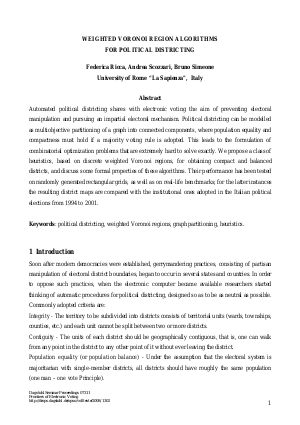Weighted Voronoi Region Algorithms for Political Districting
Authors Bruno Simeone, Federica Ricca, Andrea Scozzari
-
Part of:
Volume:
Dagstuhl Seminar Proceedings, Volume 7311
Part of: Series: Dagstuhl Seminar Proceedings (DagSemProc) - License:
 Creative Commons Attribution 4.0 International license
Creative Commons Attribution 4.0 International license
- Publication Date: 2008-01-15
File

PDF
DagSemProc.07311.9.pdf
- Filesize: 273 kB
- 15 pages
Document Identifiers
Subject Classification
Keywords
- Political districting
- weighted Voronoi regions
- graph partitioning
- heuristics
Metrics
- Access Statistics
-
Total Accesses (updated on a weekly basis)
0Document
0Metadata
Abstract
Automated political districting shares with electronic voting the aim of preventing electoral manipulation and pursuing an impartial electoral mechanism. Political districting can be modelled as multiobjective partitioning of a graph into connected components, where population equality and compactness must hold if a majority voting rule is adopted. This leads to the formulation of combinatorial optimization problems that are extremely hard to solve exactly. We propose a class of heuristics, based on discrete weighted Voronoi regions, for obtaining compact and balanced districts, and discuss some formal properties of these algorithms. Their performance has been tested on randomly generated rectangular grids, as well as on real-life benchmarks; for the latter instances the resulting district maps are compared with the institutional ones adopted in the Italian political elections from 1994 to 2001.
Cite As Get BibTex
Bruno Simeone, Federica Ricca, and Andrea Scozzari. Weighted Voronoi Region Algorithms for Political Districting. In Frontiers of Electronic Voting. Dagstuhl Seminar Proceedings, Volume 7311, pp. 1-15, Schloss Dagstuhl – Leibniz-Zentrum für Informatik (2008)
https://doi.org/10.4230/DagSemProc.07311.9
BibTex
@InProceedings{simeone_et_al:DagSemProc.07311.9,
author = {Simeone, Bruno and Ricca, Federica and Scozzari, Andrea},
title = {{Weighted Voronoi Region Algorithms for Political Districting}},
booktitle = {Frontiers of Electronic Voting},
pages = {1--15},
series = {Dagstuhl Seminar Proceedings (DagSemProc)},
ISSN = {1862-4405},
year = {2008},
volume = {7311},
editor = {David Chaum and Miroslaw Kutylowski and Ronald L. Rivest and Peter Y. A. Ryan},
publisher = {Schloss Dagstuhl -- Leibniz-Zentrum f{\"u}r Informatik},
address = {Dagstuhl, Germany},
URL = {https://drops.dagstuhl.de/entities/document/10.4230/DagSemProc.07311.9},
URN = {urn:nbn:de:0030-drops-13024},
doi = {10.4230/DagSemProc.07311.9},
annote = {Keywords: Political districting, weighted Voronoi regions, graph partitioning, heuristics}
}
